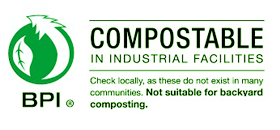
PLA can degrade into innocuous lactic acid, so it is used as medical implants in the form of anchors, screws, plates, pins, rods, and as a mesh. Depending on the exact type used, it breaks down inside the body within 6 months to 2 years. This gradual degradation is desirable for a support structure because it gradually transfers the load to the body (e.g. the bone) as that area heals. The strength characteristics of PLA and PLLA implants are well documented.

PLA can also be used as a decomposable packaging material, either cast, injection-molded, or spun. Cups and bags have been made from this material. In the form of a film, it shrinks upon heating, allowing it to be used in shrink tunnels. It is useful for producing loose-fill packaging, compost bags, food packaging, and disposable tableware. In the form of fibers and nonwoven fabrics, PLA also has many potential uses, for example as upholstery, disposable garments, awnings, feminine hygiene products, and diapers. Thanks to its biocompatibility and biodegradability, PLA has also found ample interest as a polymeric scaffold for drug delivery purposes.
PBAT is classified as a random copolymer due to its random structure. This also means that it cannot crystallize to any significant degree due to the absence of any kind of structural order. This leads to several physical properties: wide melting point, low elastic modulus and stiffness, but high flexibility and toughness. The flexibility and toughness of this polymer make it ideal for blending with another biodegradable polymer that is strong and rigid for bottle production.
The drawback of this polymer is that if it has high flexibility and toughness, then it will not be strong and rigid. This makes it non-ideal for any situation in which a strong, rigid container is desired. An example of this would be transparent barriers, such as those made of plexiglass (Poly(methyl methacrylate)), a transparent glass substitute.
PBAT is fully biodegradable when composted due to the presence of butylene adipate groups. The high stability and mechanical properties come from the terephthalate portions.
| LAB Test Report (PDF) | Download |
| OK Compost Certificate (PDF) | Download |
| TUV Austria Certificate | Download |









